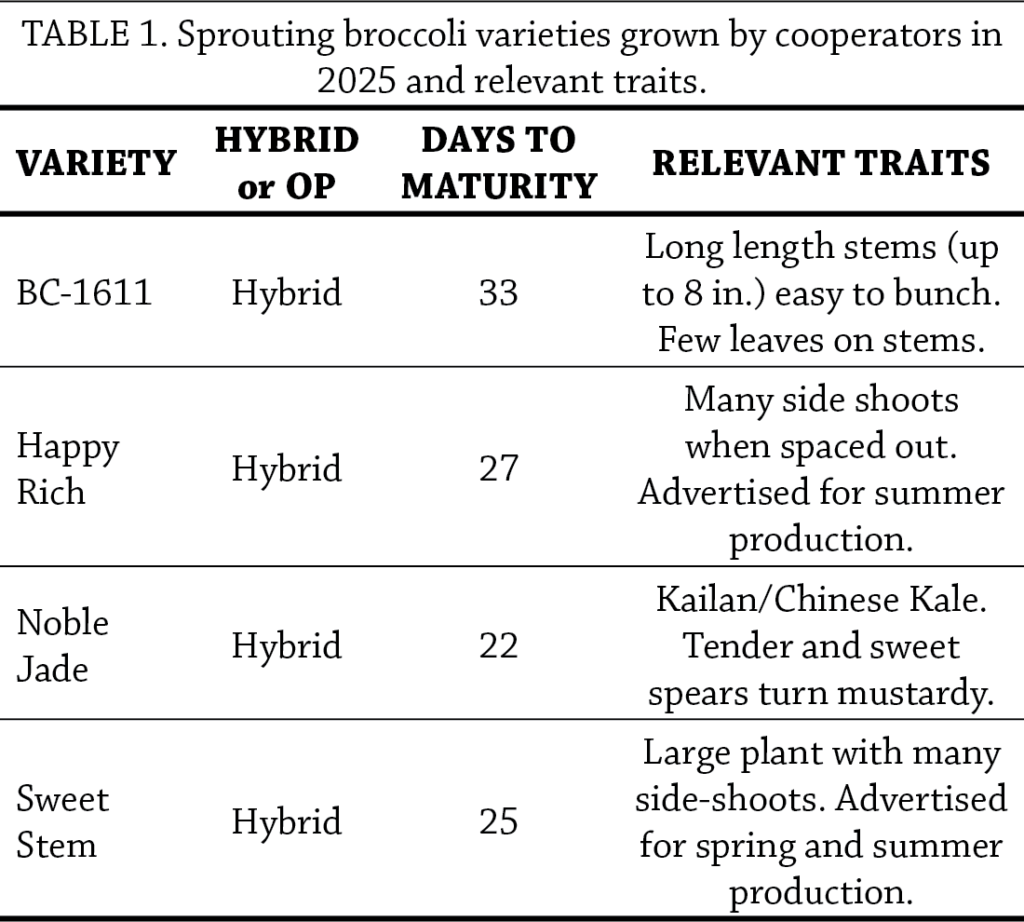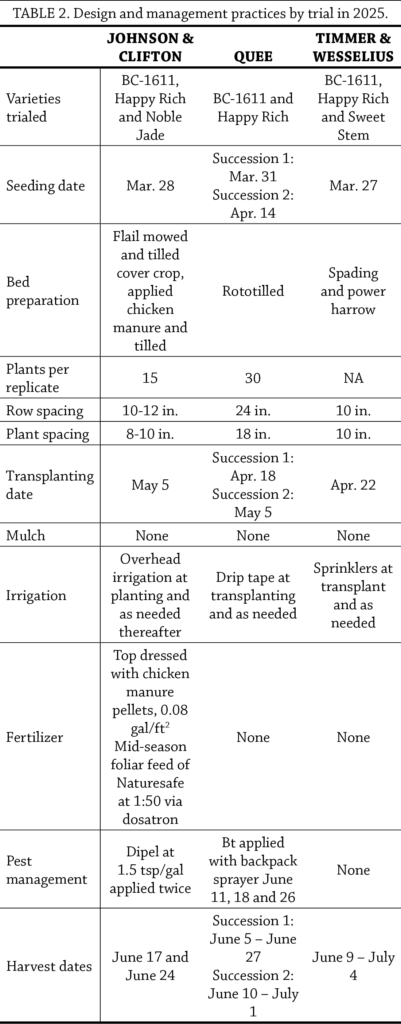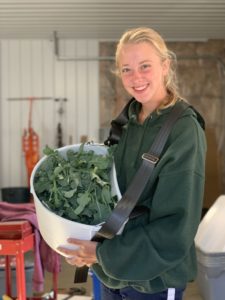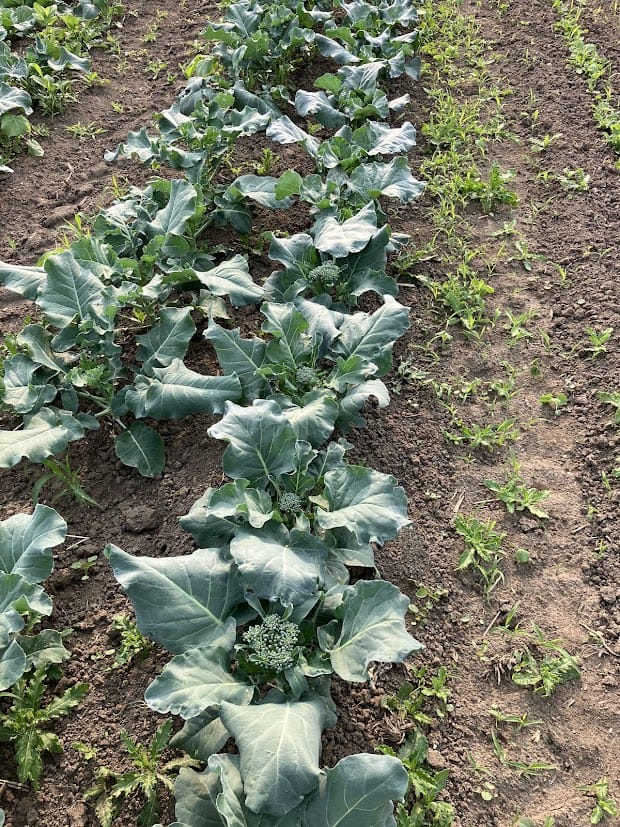This research was funded by IDALS and The Builders Initiative.
In a Nutshell:
- Sprouting broccoli is an increasingly popular brassica that grows quickly and has sweet and tender stems. The plant produces small, loose and long-stemmed florets that can be continuously harvested for weeks.
- Three PFI farmers completed a trial to determine which popular variety of sprouting broccoli performed best as their spring planting.
- Some participating farmers previously had grown a lot of sprouting broccoli and wondered if a particular variety would work best on their farm. Others were new to the crop and wondered if it would be harvestable earlier than their spring broccoli planting.
Key Findings
- Matt Johnson & Tiff Clifton found that Happy Rich yielded best on their farm. They were only able to harvest twice before the plants bolted, so next year they want to plant their sprouting broccoli earlier to hopefully get a longer season.
- Mark Quee found that BC-1611 yielded better than Happy Rich in his first succession but the same in his second. He is satisfied that the sprouting broccoli produced a crop before his earliest broccoli and plans to continue growing it.
- Wesselius and Timmer decided that Happy Rich was their least favorite variety despite it being higher yielding on their farm. They found that the crown shape was odd, it flowered quickly and it had a short harvest window.
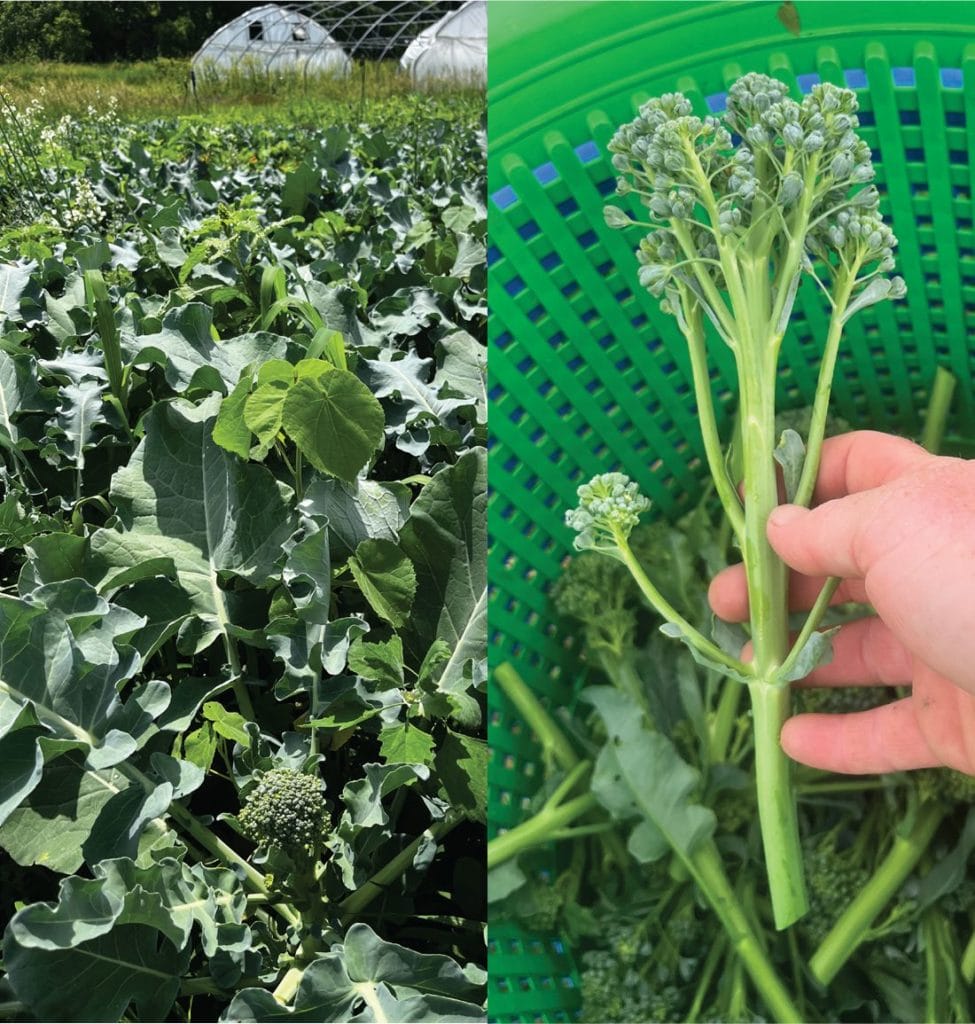
Sprouting broccoli in Matt Johnson and Tiff Clifton’s trial. (Left) Plants before their first harvest on June 17. (Right) Sprouting broccoli harvested at their second harvest date on June 24.
Background
Sprouting broccoli is an increasingly popular brassica that many Iowa farmers are learning to grow and market. Sprouting broccoli produces small, broccoli-like heads with long, tender stems that can be continuously harvested. It grows more quickly than broccoli and can have up to a month-long harvest window in good conditions. For these reasons, many farmers are investigating sprouting broccoli as an early season crop, ready before their first planting of broccoli.
This spring and summer, Matt Johnson & Tiff Clifton, Mark Quee and Ana Timmer & John Wesselius participated in a trial comparing yields of two or more popular varieties of sprouting broccoli planted. Each farm trialed two varieties called BC-1611 and Happy Rich, and Johnson & Clifton and Timmer & Wesselius each trialed a third. The farmers evaluated yield of each variety and also noted qualities that they did or did not like.
The three farms had different levels of experience growing sprouting broccoli going into the trial and also had different goals. Quee had not tried it before and wanted to “have a better sense of which variety works best on our farm and have a better idea of when to start seeds and transplant.” Ana Timmer, in contrast, remarked that “we grow a lot of sprouting broccoli on our farm, and we’re looking to learn more about how different varieties respond to weather conditions (cool vs. heat). We might change our variety planting schedule based on what we learn.” Finally, Matt Johnson and Tiff Clifton were new to the Cooperators’ Program and to growing sprouting broccoli. They were excited to learn from the experience of completing their first on-farm trial.
Methods
Design
Johnson & Clifton and Quee planted four replicates of varieties BC-1611 and Happy Rich. Johnson & Clifton also included a third variety, Noble Jade. Quee planted trials in two successions (Table 2). Timmer & Wesselius were unable to replicate due to planting error but measured total harvest yields of BC-1611, Happy Rich and Sweet Stem. Relevant traits about each trialed variety are found in Table 1, and trial planting and management details for each farm are shown in Table 2.
Measurements
At each harvest date, farmers weighed sprouting broccoli yield from each replicate. Farmers used their discretion when deciding what sprouting broccoli to harvest and when to harvest. For example, Johnson & Clifton harvested flowered stems that they felt were still salable and had a much shorter harvest window than the other two farms due to hot conditions causing the plants to bolt.
Quee experienced some transplant failure and cultivator blight, so he also counted the number of plants in each replicate each time he harvested. His yield results are reported on a per plant basis.
Data analysis
We used an ANOVA (Analysis of Variance) at a 90% confidence level to determine if there were significant differences in yield between varieties at Johnson & Clifton’s and at Quee’s. For Johnson & Clifton’s data, we tested whether variety and/or replication contributed to sprouting broccoli yield (2-way ANOVA). Since ANOVA identified significant variance in yield by variety, we followed ANOVA with a Tukey’s Honest Significant Difference test (HSD). For Quee’s data, we additionally tested whether succession contributed to yield (3-way ANOVA). We could perform statistical analysis at Johnson & Clifton’s and Quee’s because they had replicated and randomized experimental designs (Figure A1).
Results and Discussion
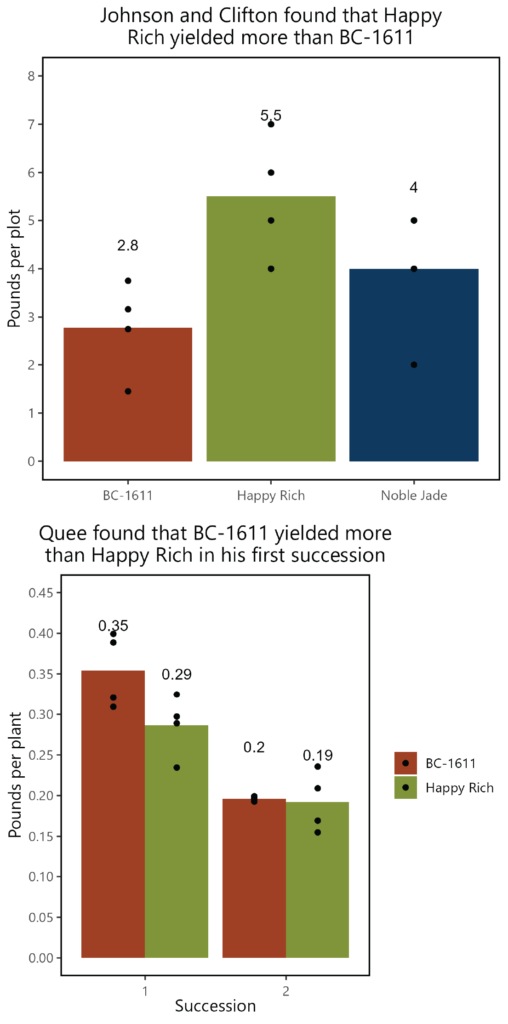
Figure 1: Sprouting broccoli yields in Matt Johnson & Tiff Clifton’s (top) and Mark Quee’s (bottom) trials in 2025. Dots indicate the yield of each individual replicate (four for each variety). Bars and numbers above the bars indicate the average yield of each variety. Mark Quee found that BC-1611 yielded significantly more than Happy Rich in his first succession, and yields were significantly lower for varieties in succession two compared to succession one. Matt Johnson found that Happy Rich yielded significantly more than BC-1611 and Noble Jade.
Johnson & Clifton were able to harvest from all their sprouting broccoli plants once on June 17. They were able to harvest only BC-1611 a second time on June 24. Despite only being harvested on one date, they found that Happy Rich (5.5 lb/plot) yielded about twice as much as the cumulative two harvests of BC-1611 (2.8 lb/plot), and about 30% more than Noble Jade (4.0 lb/plot) at the 90% confidence level (Figure 1, top).
In contrast, Quee found that over the course of the 17–19-day harvest window of his first succession of sprouting broccoli, BC-1611 (0.35 lb/plant) yielded more than Happy Rich (0.29 lb/plant) at the 90% confidence level (Figure 1, bottom). Both varieties yielded statistically significantly higher in the first succession compared to the second succession (0.2 lb/plant for both), likely due to hotter weather at planting and over the course of the second succession. Happy Rich did have an advantage compared to BC-1611 — it produced harvestable heads five-to-six days before BC-1611 in both successions (Table 3).
Timmer & Wesselius were unable to replicate their trial, so their results could not be analyzed. Over the course of their harvest window, they harvested about 43 lb of BC-1611, 94 lb of Happy Rich, and 62 lb of Sweet Stem sprouting broccoli. Similarly to Quee, they were able to harvest Happy Rich and Sweet Stem about a week before BC-1611, but BC-1611 had one harvest after Happy Rich was done (Table 4).

In addition to measuring the yield of each variety, the farmers observed different traits in the varieties that made them more or less likely to grow them again. They all noted that BC-1611 produced larger single heads than the other varieties. Timmer noted that their farm did not like Happy Rich’s crown shape, which was very branching, and found that it bolted quickly in the heat; though it may have yielded more, it was their least favorite variety. While Johnson & Clifton also preferred BC-1611, they enjoyed the taste of Happy Rich. They did not like the quality of Noble Jade and will probably not try that variety again.
Quee thinks that he will continue to grow both Happy Rich and BC-1611 because “I like the relay harvests of these two varieties – Happy Rich about a week earlier than BC-1611, but BC-1611 with considerably larger heads.” He sees sprouting broccoli as a great way to extend the broccoli season a bit earlier but still prefers broccoli. “Our early season broccoli (Green Magic) was ready June 17, and I would likely not continue harvesting sprouting broccoli after that except as a supplement for the main broccoli crop.”
Conclusions and Next Steps
All participating farmers were pleased that their trials allowed them to learn more about growing sprouting broccoli on their farms. Both Quee and Johnson & Clifton found that the new crop works for their farm, and they will grow it again. Johnson & Clifton observed that the other farms, who planted earlier, had a longer harvest window, and note that “we will definitely get sprouting broccoli in the ground earlier next year.” Timmer and Wesselius, who already grew sprouting broccoli all summer long before the trial, see more opportunity to experiment with different varieties in the future. “Doing successive trials all summer would give a clear picture of early summer varieties over late summer varieties.”
Appendix – Trial Design and Weather Conditions

Figure A1. Example randomized experimental design used by Johnson & Clifton and Quee. Letters represent different sprouting broccoli varieties.
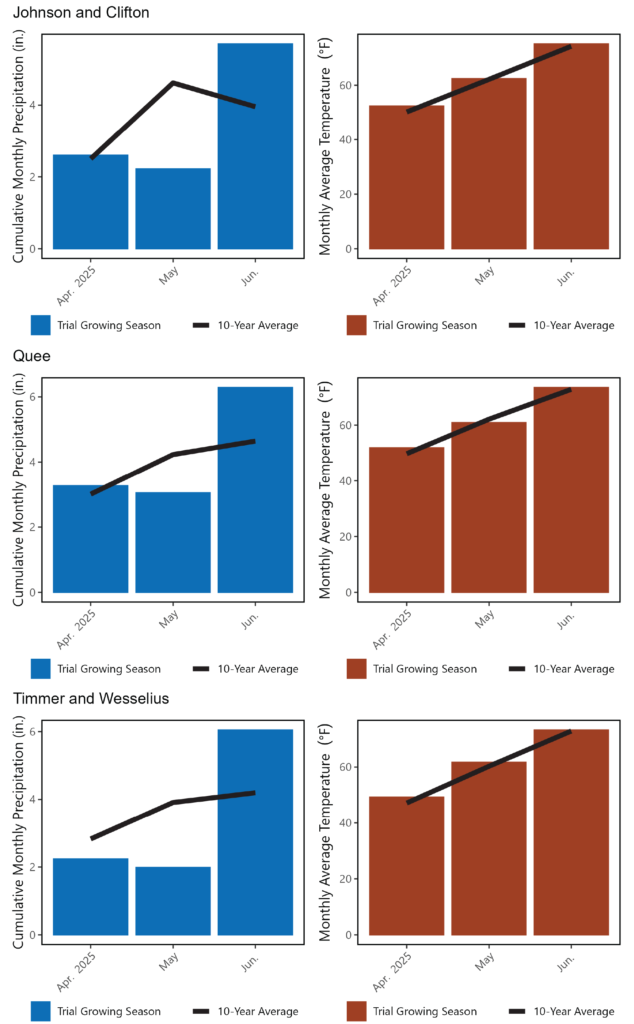
Figure A2. Monthly cumulative precipitation and average temperatures in Council Bluffs (Johnson and Clifton), West Branch (Quee) and Sioux Falls (Timmer and Wesselius) [1], [2].
Funding Acknowledgement
Funding for this project was made possible by a grant/cooperative agreement from the U.S. Department of Agriculture (USDA) Agricultural Marketing Service. Its contents are solely the responsibility of the authors and do not necessarily represent the official views of the USDA.
References
[1] A. H. Sparks, “nasapower: A NASA POWER Global Meteorology, Surface Solar Energy and Climatology Data Client for R,” J. Open Source Softw., vol. 3, no. 30, p. 1035, Oct. 2018, doi: 10.21105/joss.01035.
[2] A. Sparks, nasapower: NASA-POWER Data from R. (2024). [Online]. Available: https://CRAN.R-project.org/package=nasapower


